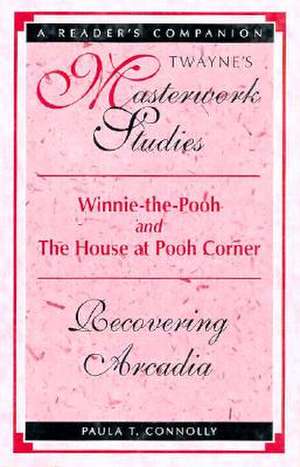Masterwork Studies Series: Winnie-The-Pooh: Twayne's Masterworks Studies, cartea 156
Autor Paula T. Connollyen Limba Engleză Hardback – 30 noi 1994
Din seria Twayne's Masterworks Studies
- 23%
 Preț: 449.34 lei
Preț: 449.34 lei -
 Preț: 377.65 lei
Preț: 377.65 lei -
 Preț: 344.04 lei
Preț: 344.04 lei -
 Preț: 454.10 lei
Preț: 454.10 lei -
 Preț: 432.73 lei
Preț: 432.73 lei -
 Preț: 452.73 lei
Preț: 452.73 lei -
 Preț: 522.80 lei
Preț: 522.80 lei -
 Preț: 207.23 lei
Preț: 207.23 lei -
 Preț: 321.90 lei
Preț: 321.90 lei -
 Preț: 434.85 lei
Preț: 434.85 lei -
 Preț: 274.30 lei
Preț: 274.30 lei -
 Preț: 434.64 lei
Preț: 434.64 lei -
 Preț: 432.88 lei
Preț: 432.88 lei -
 Preț: 359.34 lei
Preț: 359.34 lei -
 Preț: 209.56 lei
Preț: 209.56 lei -
 Preț: 497.93 lei
Preț: 497.93 lei -
 Preț: 475.05 lei
Preț: 475.05 lei -
 Preț: 349.31 lei
Preț: 349.31 lei -
 Preț: 348.89 lei
Preț: 348.89 lei -
 Preț: 349.31 lei
Preț: 349.31 lei -
 Preț: 499.29 lei
Preț: 499.29 lei -
 Preț: 455.79 lei
Preț: 455.79 lei -
 Preț: 456.98 lei
Preț: 456.98 lei -
 Preț: 350.47 lei
Preț: 350.47 lei -
 Preț: 288.91 lei
Preț: 288.91 lei -
 Preț: 432.35 lei
Preț: 432.35 lei -
 Preț: 347.75 lei
Preț: 347.75 lei -
 Preț: 288.69 lei
Preț: 288.69 lei -
 Preț: 272.55 lei
Preț: 272.55 lei -
 Preț: 347.36 lei
Preț: 347.36 lei -
 Preț: 321.68 lei
Preț: 321.68 lei -
 Preț: 349.48 lei
Preț: 349.48 lei -
 Preț: 349.86 lei
Preț: 349.86 lei -
 Preț: 350.47 lei
Preț: 350.47 lei -
 Preț: 455.03 lei
Preț: 455.03 lei -
 Preț: 455.79 lei
Preț: 455.79 lei -
 Preț: 453.12 lei
Preț: 453.12 lei -
 Preț: 455.03 lei
Preț: 455.03 lei -
 Preț: 456.39 lei
Preț: 456.39 lei -
 Preț: 453.50 lei
Preț: 453.50 lei -
 Preț: 454.86 lei
Preț: 454.86 lei -
 Preț: 453.30 lei
Preț: 453.30 lei -
 Preț: 351.00 lei
Preț: 351.00 lei -
 Preț: 349.09 lei
Preț: 349.09 lei
Preț: 347.75 lei
Nou
Puncte Express: 522
Preț estimativ în valută:
66.55€ • 72.26$ • 55.90£
66.55€ • 72.26$ • 55.90£
Carte indisponibilă temporar
Doresc să fiu notificat când acest titlu va fi disponibil:
Se trimite...
Preluare comenzi: 021 569.72.76
Specificații
ISBN-13: 9780805788105
ISBN-10: 0805788107
Pagini: 142
Dimensiuni: 148 x 224 x 17 mm
Greutate: 0.28 kg
Editura: Twayne Publishers
Seria Twayne's Masterworks Studies
ISBN-10: 0805788107
Pagini: 142
Dimensiuni: 148 x 224 x 17 mm
Greutate: 0.28 kg
Editura: Twayne Publishers
Seria Twayne's Masterworks Studies
Textul de pe ultima copertă
In the Forest of A. A. Milne's Winnie-the-Pooh (1926) and The House at Pooh Corner (1928), we never see any "Hostile Animals" as one the size of a piglet might fear, but instead we see a community of toy animals - Pooh Bear, Piglet, Rabbit, Eeyore, Owl, Kanga, Roo, and Tigger - who accompany their friend. Christopher Robin on his "expeditions". Companionship, safe adventuring, and the acceptance of characters' flaws and foibles are common themes throughout both books, and the episodes tend to have a similar form in which characters meet, adventure together, and then either reconcile if need be or, more frequently, return to their homes - in Pooh's case, usually for some honey. In this affectionate and balanced analysis of two of the most popular books ever written for children, Paula T. Connolly argues that Milne's toy characters and his Christopher Robin - a character modeled and named after his son - inhabit a pretechnological, Arcadian world. Milne's Forest ensures its inhabitants' safety much like the Edwardian nursery, according to Connolly - a world, she acknowledges, of privilege and class security. The 10 stories in each book function well as separate bedtime stories, but they are held together as sets not only through the same Forest world that they inhabit and the same characters who live there but also through the similarity of themes. Connolly notes that whereas the stories of Winnie-the-Pooh show a world of parties and adventuring, those of The House at Pooh Corner are a bit more sober: when the animals join together to say goodbye to Christopher Robin at the end of the book, the farewell is more muted than jubilant. The imminent departure of the child who had been seen asthe Forest's protector fundamentally reshapes the vision of the Forest as an unchanging Arcadia: such new concerns are apparent, for example, in the several incidents in which homes and characters are lost, sought after, and recovered. The interactions of the characters - and the central role of Pooh, a "Bear of Very Little Brain" - are thoroughly analyzed, and Connolly looks at how the thematic structures of Milne's two poetry collections for children - When We Were Very Young (1924) and Now We Are Six (1927) - are echoed in the two storybooks. Connolly also addresses the widespread commercialization and appropriation of Milne's characters, looking particularly at the Disney film and television versions of the stories and pointing out the distortions of Milne's characters as they have been adapted by the current culture. This comprehensive and insightful survey of Milne's masterworks also includes a helpful guide to teaching the stories, suggesting discussion topics and performance procedures that will allow students to understand the original dimensions of Milne's Forest world.
